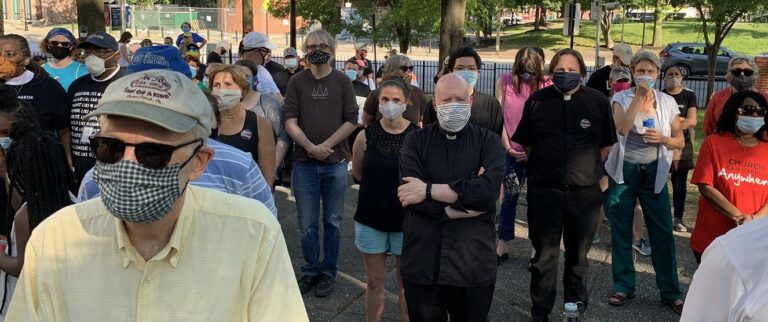Baltimore Archbishop William E. Lori joined faith leaders from across the city June 3 to pray for peace and healing after more than a week of nationwide protests and unrest in response to the death of George Floyd at the hands of four Minneapolis police officers.
Despite the coronavirus pandemic keeping most Marylanders inside their homes, about 250 masked people filled the park outside St. Vincent de Paul Church in the heart of downtown near Baltimore Police Headquarters and City Hall. The event was also livestreamed on Facebook, where it was viewed more than 7,900 times.
A group of Lutheran parishioners held banners reading “Racism is a Sin” and “Thoughts and Prayers and Action.” Catholic priests such as Father Joshua Laws, pastor of the Catholic Community of South Baltimore, held homemade protests signs. His read, “Black Lives Matter.”
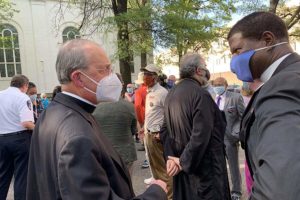
“The spectacle of the killing of George Floyd that outraged the country once again has shaken us from the mount behind the walls where we so readily hide,” Archbishop Lori said as he opened the service. “But we are confronted with the ongoing suffering of people of color who suffer from the sin of racism.
“We felt compelled to come together in this moment, compelled to come together with our elected officials, our civic leaders and members of our congregation simply to pray.”
Faith leaders from Jewish, Muslim and Christian communities attended the service along with local leaders, including Baltimore Police Commissioner Michael Harrison, U.S. Rep. John Sarbanes and City Councilman Eric Costello.
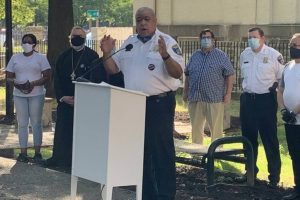
“Certainly, we are in tough times, tumultuous times, and much, if not most, of what we are feeling is because of law enforcement,” Harrison said. “It is our duty and our responsibility to be proactive, to bring about change. And so we are certainly happy to be a part of an interfaith prayer service, because prayer is the thing that gives us hope that we can get better, that we can heal, and that we can change.”
The faith leaders and community members offered nine prayers to symbolize the nearly nine minutes Floyd suffered as Officer Derek Chauvin restrained him by putting his knee against Floyd’s neck, cutting off his breathing.
Darlene Cain, whose son was killed by a Baltimore City police officer, offered a prayer for Floyd, urging healing between the police and the community.
“We’re here for the hurt that we feel for George Floyd. We are here hurting, God, our families, our children,” Cain prayed. “For all that’s gone on, all the video that’s gone viral. God help us. God help us to believe that we’re going to be alright again one day.”
Ray Kelly, a parishioner of St. Peter Claver in West Baltimore and director of the Citizens Policing Project, offered a prayer for the city and called for the just treatment of all.
“As I pray for our city and our residents, I hope this demonstration and service today is also a reminder that we have strength, we’ve walked this path before and we are enduring this type of situation with the utmost legitimacy,” he said.
The service ended with a solemn nine minutes of silence interrupted every minute by the sound of a single bell tolling. Many who attended bowed their heads and kneeled.
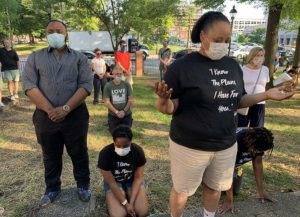
(Tim Swift/CR Staff)
Floyd’s death was recorded by bystanders and the video has been viewed around the world by millions. Bystanders repeatedly pleaded with the officers that Floyd was struggling to breathe and Floyd himself can be heard on the video begging for help.
Police officers said Floyd appeared to be visibly drunk and had used a counterfeit $20 earlier in the day. An autopsy commissioned by his family found that Floyd died of asphyxiation. However, the medical examiner determined the cause of death as cardiopulmonary arrest or heart failure.
Chauvin has been fired and charged with second-degree murder. Three officers – Thomas Lane, J. Alexander Kueng and Tou Thao, – were also fired and charged with aiding and abetting second-degree murder.
However, Chauvin was not charged for several days and he initially faced a lesser charge of third-degree murder. The other officers were charged June 3 – more than a week after Floyd’s death. Those delays – along with years of similar in-custody deaths of black people at the hands of police officers – helped fuel the nationwide protests that have grown to include almost every major U.S. city.
During the mass protests, a police station was set on fire in Minneapolis and stores have been looted in cities across the country, drawing condemnation from President Donald Trump and other conservative leaders. Protest organizers argue that the looters were opportunistic criminals and outside agitators. They represent a small minority compared to the millions of people demonstrating peacefully, organizers said.
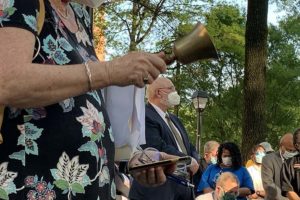
Protesters have been calling for an end to the police brutality that disproportionately targets people of color. A recent Washington Post analysis found that black people are twice as likely as white people to die at the hands of police despite being only 13 percent of the population. Protesters have also urged Americans to address issues of systemic racism that can affect access to quality healthcare, housing, education and employment.
While Baltimore experienced widespread unrest and destruction of property after the in-custody death of Freddie Gray in 2015, the current demonstrations in the city have largely been peaceful.
Indeed, when a group of protestors marched past St. Vincent de Paul Church and Baltimore Police Headquarters chanting “No Justice. No Peace” people at the prayer service applauded and cheered.
“We are the protesters,” said the Rev. Brenda White, the pastor of Allen AME Church in West Baltimore, who attended the service. “This is where we decide that we are going to represent Christ and love to protest the status quo. Who would be indifferent? So the mere fact that we are here, it is a protest against evil.”
And she had some encouragement for protestors as the demonstrations continued.
“Do it with grit and grace. Be determined to be resilient and show the shape of God’s law and God’s compassion for this world,” Rev. White said.
Email Tim Swift at tswift@catholicreview.org
Copyright ©2020 Catholic Review Media.

